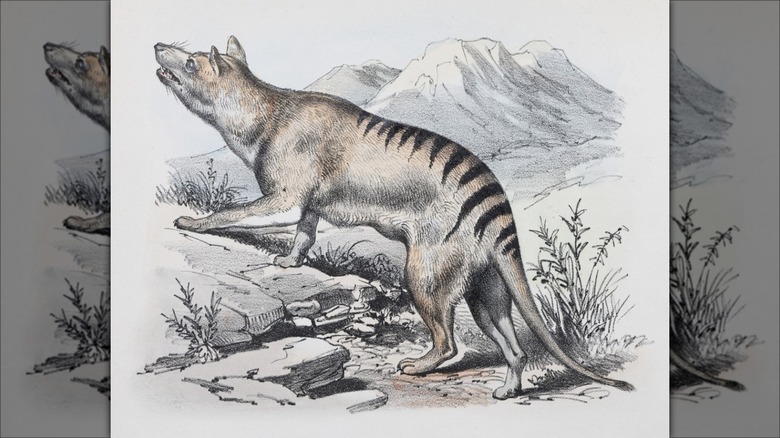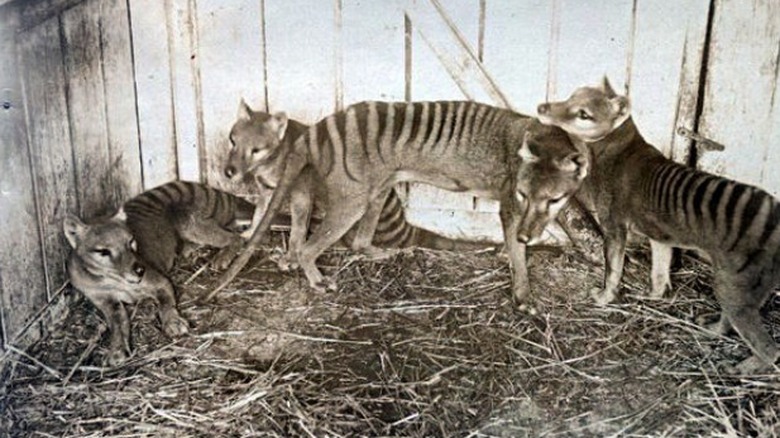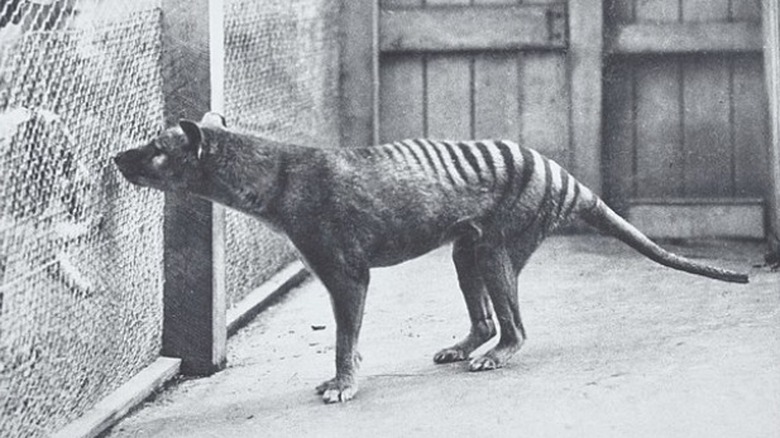The Real Reason The Tasmanian Tiger Went Extinct
The thylacine or Tasmanian tiger — the largest known marsupial carnivore in history, and a cousin of the Tasmanian Devil — once roamed much of Australia, Papua New Guinea, and Tasmania. Although some people in those parts of the world still claim to see them, the last-known Tasmanian tiger named Benjamin, died on September 7, 1936, in the Beaumaris Zoo in Hobart, the capital city of Tasmania, an Australian state — less than two months after the species received protected status. At that point, science declared the Tasmanian tiger extinct, as The New York Times reports. How, exactly, though, did this funny-looking creature once populous in the area, and seemingly part dog and part tiger with a long tail, similar to a kangaroo, get wiped off the face of the planet?
The story of the Tasmanian tiger's decline begins with European colonization of Tasmania, an island off the coast of mainland Australia, as The Times goes on to write. These dog-headed pouched animals known as thylacines had unique tiger-like stripes. A partially nocturnal creature, they also liked the quiet and tended to avoid human contact, according to the National Museum of Australia (NMA). Home to Aboriginal Tasmanians (via Our Tasmania) the first European Tasmanian colonists, the Dutch, arrived in the 1640s, per Britannica. By the early 19th century, Tasmania, then called Van Diemen's Land, fell under British control, and along with the native people of Tasmania, the British arrival spelled disaster for the Tasmanian tiger.
Tasmanian tigers lost habitat and were threatened by disease
As The New York Times explains, once the English colonists arrived on Tasmania — called Van Diemen's Land until 1856 (via Britannica) — the Tasmanian tiger, known as coorinna, loarinna, laoonana, or lagunta to the indigenous native population — were threatened by hunting, disease, and loss of habitat (per Natural Worlds). Over time, the Tasmanian tiger which once thrived in three countries became solely confined to Tasmania, according to Untamed Science. Colonists took dogs to their new home and one theory supposes that these canines and the new diseases they brought with them to the area. At that point, the thylacine had vanished on the Australian mainland some thousands of years earlier, according to The Conversation.
As well as disease, Europeans hunted the animals, believing the creatures would kill their livestock. The Tasmanian government created a bounty system, paying sums to more than 2,000 claims, which greatly accelerated the tiger's extinction. Yet evidence indicates that most of the worries about Tasmanian tigers killing livestock were exaggerated. According to The Conversation, some naturalists believe since the tigers had an extended snout and dental features incompatible with bone-crushing, the creatures probably ate much smaller prey like possums and bandicoots, rather than larger farm animals like sheep.
Thylacines also tended to breed slowly, having up to four youngsters at a time — far fewer than some other mammals, per Untamed Science. By the early 20th century, thylacine populations in Tasmania were in rapid decline, culminating with the death of the last known Tasmanian tiger in the '30s (via The Conversation).
The last known Tasmanian tiger died from exposure
As Tasmanian tiger populations began their rapid decline in the early 1900s, humans in the area took note. At the time, conservation efforts largely took the form of capturing all surviving thylacines to put them in zoos around the world. As Untamed Science explains, this created a "Tasmanian tiger rush" and large sums were paid for living specimens. Shortly before the last known Tasmanian tiger died, Tasmanian lawmakers declared the species protected, but their efforts were too little late to help Benjamin. While in a Tasmanian zoo, Benjamin got locked out of his shelter one cold night and died from exposure — the last thylacine gone from neglect. And with that, the Tasmanian tiger became extinct. Or did it?
To this day, there's controversy about whether there may be some Tasmanian tigers still living in the wild. For example, the Thylacine Awareness Group of Australia, a not-for-profit organization devoted to the animal, claimed that a camera trap took photos of a family of three. Zoology expert Nick Mooney from the Tasmanian Museum and Art Gallery looked at the footage and ascertained that assertion was wrong. The animals pictured were unlikely to be thylacines, and most likely Tasmanian pademelons, via The Guardian.
For now, science says the thylacine is gone for good, but perhaps not for long. After Benjamin's death, the creature's remains, once misplaced, were found at the 2022 Tasmanian Museum and Art Gallery in Hobart, Tasmania (per NPR). DNA from those remains may lead to the animal's "de-extinction," according to Scientific American.


